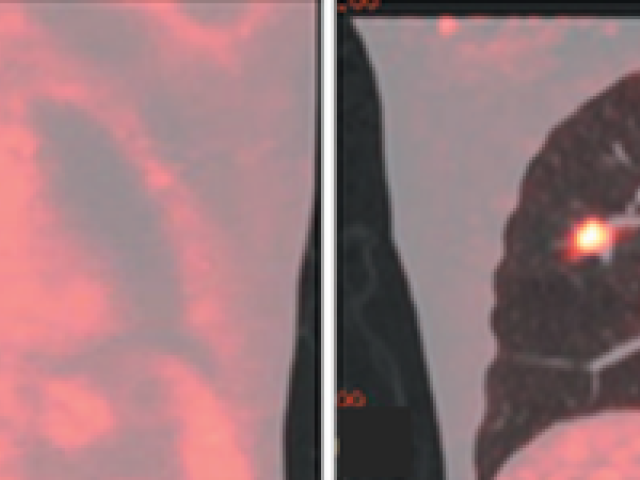Development of theranostic ligands and targeted radiotherapeutics
In work that has been collectively recognized by the European Association of Nuclear Medicine in the form of a Young Investigator Award, and by the Society of Nuclear Medicine and Molecular Imaging in the form of an Alavi-Mandell Award, Dr. Kelly has exploited serum albumin as a method of modifying the pharmacokinetics of small molecule prostate specific membrane antigen (PSMA) ligands, thereby...
Imaging metabolism
The Kelly lab is currently funded by the National Institutes of Health (NIH) (National Institute of Biomedical Imaging and Bioengineering (NIBIB) R21 Trailblazer Award) to develop carbon 11 (11C)-labeled isotopologues of pyruvate for imaging prostate cancer. Prostate cancer is the most widely diagnosed cancer in men, yet few validated biomarkers for accurate disease staging, identification of...
Imaging biomarkers in heart failure
Awards or Grants: National Cancer Institute (NCI) R21The Kelly lab is currently funded by the NCI to validate imaging biomarkers of cardiotoxicity. Many patients are at risk of developing cardiotoxicity as a result of their cancer treatment. Damage is typically detected by echocardiography, but by the time it can be seen via this modality, the damage may be irreversible. The lab’s hypothesis is...
Alpha particle based theragnostics
Clinical trial-based research to expand the use of alpha particle-based therapeutics. Actinium-225 is a radiopharmaceutical we will be producing in the first-of-its-kind alpha labeling lab in an academic institution. The image demonstrates an example of how we hope to benefit patients seeking cancer care through this institutional lab.IRB Approvals:IRB #AML02. A Phase I/II Study of Venetoclax and...
Academic Industrial Partnership (AIP) to make gallium 68 more available
Awards or Grants: National Institutes of Health (NIH) Academic Industrial Partnership (AIP) with an R1 grant award for “[a] new technique to make 68Ga-labeled pharmaceuticals widely available for clinical use.”This recently completed National Institutes of Health (NIH) grant found a method to produce large quantities of gallium 68 from a cyclotron with solid targets so that this radiotracer can...
Multi-parametric SUV/Patlak 68Ga-PSMA PET/CT imaging for prostate cancer diagnosis and treatment response monitoring
Prostate cancer is one of the leading causes of cancer death among men in the U.S. and worldwide. The Prostate-Specific Membrane Antigen (PSMA) is a transmembrane protein expressed in all types of prostatic tissue and is broadly recognized as a useful diagnostic and therapeutic agent for prostate cancer. Static whole-body (WB) positron emission tomography/computed tomography (PET/CT), using the...
Development of computationally efficient Monte-Carlo simulations, customized PET data acquisition protocols and image reconstruction methods for adaptively sparse PET scanner geometries
The lab has recently introduced at Weill Cornell Medicine (WCM) the concept of a cost-effective positron emission tomography (PET) detector geometry with adaptable axial field of view (AFOV) via a published series of realistic Monte Carlo simulation studies. The proposed PET systems employ a robust gantry motion mechanism to repeatedly adapt the degree of sparsity between detector blocks to...
Monte-Carlo simulation and resolution modeling of a mini-ring dedicated PET scanner that directly measures ankle/wrist arterial input function
The lab is developing a realistic Monte-Carlo (MC) simulation of a dedicated mini-positron emission tomography (PET) cylindrical scanner designed for the direct non-invasive tomographic measurement of the dynamic activity concentration of a PET radiotracer in the arteries, known as arterial input function, crossing through the human ankle or wrist. The MC model will be based on previously...
Correction for respiratory motion in PET/CT
Dr. Sadek Nehmeh’s work in respiratory motion correction in combined positron emission tomography (PET)/computed tomography (CT) images was the first worldwide. He developed multiple methodologies to correct for breathing-induced artifacts, and his work on motion correction in PET/CT was awarded research grants from the National Institutes of Health (NIH) and General Electric (GE) Medical Systems...
Cancer-induced cardiac toxicity
In breast cancer radiotherapy, the mean heart dose is currently 1–5 Gy. Exposures at these levels can cause ischemic heart disease that worsens within five years post-radiation, then continues into the third decade. Determining radiation-induced cardiac toxicity soon after radiotherapy allows for early assessment and intervention of heart disease. Currently, detecting changes in myocardial...











